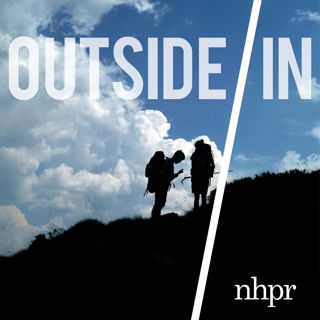
What is a forest for?
In New Hampshire, the most beloved swath of public land is the White Mountain National Forest. People interact with it as they would a national park – hiking, swimming, camping, and more. But a national forest is NOT a national park. The difference comes down to a fundamental concept: the “multiple-use” land mandate. In the WMNF, you’ll find parts of the forest preserved for wildlife conservation, recreation, climate resilience, and, most controversially, logging. This episode looks at one patch of forest from three different perspectives: a conservationist who would like to see cutting halted in the WMNF, loggers who would like to see it ramped up, and the US Forest Service that has to somehow appease them both. Featuring Zack Porter, Jeremy Turner, Charlie Niebling, Jasen Stock, Jim Innes, and Luke Sawyer.SUPPORTTo share questions and feedback with Outside/In, call the show’s hotline and leave us a voicemail. The number is 1-844-GO-OTTER. No question is too serious or too silly.Outside/In is made possible with listener support. Click here to become a sustaining member of Outside/In. Follow Outside/In on Instagram or join our private discussion group on Facebook.LINKSZack Porter references this study that shows the potential carbon storage in Eastern forests by 2100. Conservation groups and logging advocates filed an amicus brief together against Standing Tree’s lawsuits. In 2024, the Southern Environmental Law Center sued the Forest Service over its timber targets. NHPR has been covering the legal fight in the White Mountain National Forest over the past year. You can read some of our previous coverage here and here. CREDITSProduced by Kate Dario. Full credits and transcript available on outsideinradio.org. Hosted by Simplecast, an AdsWizz company. See pcm.adswizz.com for information about our collection and use of personal data for advertising.
20 Feb 28min

FEMA and the other 50 percent
It seems like every morning, another arm of the federal government is being reformed, eliminated, or downsized. That might wind up including an agency that a lot of Americans rely on when disaster strikes: FEMA.President Trump has called FEMA a “disaster.” His new head of homeland security, Kristi Noem, has signaled it’s time to “get rid of FEMA the way it exists today.” FEMA is a big agency, and understanding its role can be difficult in the abstract. So this week, we’re playing an episode from one of our favorite public radio podcasts: Sea Change. It’s all about something called the “50% Rule.” Host Carlyle Calhoun travels to two towns to discover how this obscure federal policy designed to stop the cycle of flood damage is leading to opposite destinies.For full credits and transcript, visit outsideinradio.org.SUPPORTOutside/In is made possible with listener support. Click here to become a sustaining member of Outside/In. Follow Outside/In on Instagram or join our private discussion group on Facebook. Hosted by Simplecast, an AdsWizz company. See pcm.adswizz.com for information about our collection and use of personal data for advertising.
13 Feb 28min

The Great Grand Canyon Burro Rescue
In the early 1980s, an animal rights group airlifted nearly 600 wild burros out of Grand Canyon National Park. The media ate it up – magazines sold full-page ads advertising the cause and families from the East Coast clamored to adopt the rescued animals.But conflict around wild burros in the West still exists today. What does one of the flashiest rescue stories of the last century tell us about the power of animal activism to make enduring change? Featuring Rebbel Clayton, Abbie Harlow, John MacPete, Dave Sharrow, Travis Ericsson, and Eric Claman. For a transcript and full list of credits, go to outsideinradio.org. LINKSYou can read Abbie Harlow’s paper, “The Burro Evil” here. If you’re interested in learning more about the burro adoption process, Cynthia Brannigan outlined her experience as an employee of the Fund for Animals in her book, “The Last Diving Horse in America.” Research for this episode was also sourced from Julie Hoffman Marshall’s Making Burros Fly and Cleveland Amory’s Ranch of Dreams. Black Beauty Ranch currently houses more than 600 animals. You can read more about their work here. Check out dozens of archival shots from the rescue, via Northern Arizona University’s Cline Library. And yes, you can watch Brighty of the Grand Canyon on Youtube. SUPPORTOutside/In is made possible with listener support. Click here to become a sustaining member of Outside/In. Follow Outside/In on Instagram or join our private discussion group on Facebook. Hosted by Simplecast, an AdsWizz company. See pcm.adswizz.com for information about our collection and use of personal data for advertising.
6 Feb 36min

Order on the pickleball court!!!
Pickleball is the fastest growing sport in America. It may also be the most hated. Tennis and basketball players are complaining about losing court space because of an “invasion” of pickleballers. Residents are losing sleep because of the incessant noise. Fights over pickleball have led to a slew of petitions, calls to the police, and even lawsuits.So why do pickleball players love this sport so much? Just how annoying is it to everyone else? And what will it take for everyone to just get along? Producer Felix Poon visits one of the most popular courts in Boston to see how the drama is unfolding there.Featuring Kemardo Henry, Martha Merson, Soren Whited, and Zariyah Cherise.For a transcript and full list of credits, go to outsideinradio.org. SUPPORTOutside/In is made possible with listener support. Click here to become a sustaining member of Outside/In. Follow Outside/In on Instagram or join our private discussion group on Facebook. LINKSWant to play pickleball, but don’t want to annoy the neighbors? Check out this guide to quiet pickleball paddles.Read the petition that first raised concerns over the popularity of pickleball at the South Street Courts in Jamaica Plain.Learn more about the history of pickleball, which was invented near Seattle in Bainbridge Island, WA.For more on the various conflicts arising from pickleball’s growing popularity, read One Man’s Lonely War on Central Park Pickleball (NYTimes), and Shattered Nerves, Sleepless Nights: Pickleball Noise Is Driving Everyone Nuts (NYTimes) Hosted by Simplecast, an AdsWizz company. See pcm.adswizz.com for information about our collection and use of personal data for advertising.
30 Jan 28min

Fluoridation nation
Ever since fluoridation became widespread in the 1950s, cavities in kids have fallen drastically. The effort is considered one of the ten greatest public health achievements of the 20th century. But it’s also one of the most controversial. At really high doses, fluoride is toxic – it can calcify your ligaments and joints and even fuse your spine. It also potentially has impacts on our brains. There’s a small but growing body of research suggesting that fluoride can inhibit intelligence in children. This is still unsettled and hotly debated science but, as host Nate Hegyi finds out, in our polarized and increasingly digital world… unsettled science can quickly become doctrine. Featuring Rene Najera, Philippe Grandjean and Mark HartzlerFor a transcript and full list of credits, go to outsideinradio.org. SUPPORTOutside/In is made possible with listener support. Click here to become a sustaining member of Outside/In. Follow Outside/In on Instagram or join our private discussion group on Facebook.LINKSThe CDC has a website that tells you how much fluoride is in your drinking water. Here’s the reasoning behind the U.S. Public Health Service’s recommended limit for artificially fluoridating water. The National Toxicology Program suggests that a child’s IQ could be impacted if they or their pregnant mother ingests more than 1.5 ppm of fluoride in their water. Philippe Grandjean’s peer-reviewed study suggests that the safe level of fluoride in water for pregnant women is much lower than what the U.S. Public Health Service recommends.The American Academy of Pediatrics and the American Dental Association have cast doubt on the National Toxicology Program’s conclusions and say that the fluoride levels in U.S. waters are safe. A U.S. district court judge ordered the Environmental Protection Agency to take a second look at its limits for fluoride in the water, citing the National Toxicology Program’s monograph. Hosted by Simplecast, an AdsWizz company. See pcm.adswizz.com for information about our collection and use of personal data for advertising.
23 Jan 29min

What are Trump's Climate Plans?
What has Donald Trump claimed he would do when it comes to environmental policy in the U.S.? What happened during his last administration? And what are the limits on executive powers when it comes to treaties and global agreements?Just days before Trump’s inauguration, this episode comes to us from our friends over at Civics 101. Featuring Elizabeth Bomberg.This episode was produced by Hannah McCarthy with help from Nick Capodice and Marina Henke. For a transcript and full list of credits, go to outsideinradio.org. LINKSCheck out Nate’s episode on Biden’s climate legacy — “Is Biden a Good Climate President?” SUPPORTOutside/In is made possible with listener support. Click here to become a sustaining member of Outside/In. Follow Outside/In on Instagram or join our private discussion group on Facebook. Hosted by Simplecast, an AdsWizz company. See pcm.adswizz.com for information about our collection and use of personal data for advertising.
16 Jan 39min

The tinned fish renaissance
Sardines are in vogue. Literally. They are in Vogue magazine. They’re delicious (subjectively), good for you, and sustainable… right? Recently, a listener called into the show asking about just that.“I've always had this sense that they're a more environmentally friendly fish, perhaps because of being low on the food chain. But I'm realizing I really have no sense of what it looks like to actually fish for sardines,” Jeannie told us.The Outside/In team got together to look beyond the sunny illustrations on the fish tins. Is there bycatch? What about emissions? Are sardines overfished? If we care about the health of the ocean, can we keep eating sardines?Featuring Jeannie Bartlett, Malin Pinsky, and Zach Koehn.To share your questions and feedback with Outside/In, call the show’s hotline and leave us a voicemail. The number is 1-844-GO-OTTER. No question is too serious or too silly.For full credits and transcript, visit outsideinradio.org. SUPPORTOutside/In is made possible with listener support. Click here to become a sustaining member.Subscribe to our (free) newsletter.Follow Outside/In on Instagram or Twitter, or join our private discussion group on Facebook. LINKSIf you’re interested in finding sustainable fisheries, our sources recommended checking out Monterey Bay Aquarium Seafood Watch and the Marine Stewardship Council.Sardines (specifically, Fishwife) in Vogue. Why are tinned fishes in every boutique store, and why do all of those stores feel exactly the same? For Grub Street, Emily Sundberg reported on the digital marketplace behind the “shoppy shop.” The documentary about the epic South African sardine run is “The Ocean’s Greatest Feast” on PBS.Zach Koehn’s paper, “The role of seafood in sustainable diets.” Malin Pinsky’s research found that small pelagic fish (like sardines, anchovies, and herring) are just as vulnerable to population collapse as larger, slower-growing species like tuna. Explore the designs of historical Portuguese fish tins (Hyperallergic).An animated reading of The Mousehole CatThe last sardine cannery in the United States closed in 2010. But you can explore this archive of oral histories with former workers in Maine factories (many of them women and children). Hosted by Simplecast, an AdsWizz company. See pcm.adswizz.com for information about our collection and use of personal data for advertising.
9 Jan 34min

Once in a blue moon
The next blue moon isn’t until May 2026, but luckily for you, you won’t have to wait that long to hear the Outside/In team answering listeners’ questions. This time, we’re exploring why blue moons are cool (or even what the heck a blue moon even is) and other seasonably appropriate curiosities.What’s all the fuss about a blue moon?Should we leave the leaves?Which is a more sustainable choice: real or fake Christmas trees?What happens to Christmas tree stumps?What does all that road salt do to the environment?Featuring Asmeret Asefaw Berhe, Tim Gaudreau, Victoria Meert, and Sujay Kaushal.Thanks to Outside/In listeners Zoe, Janet, Gio, Alexi, Prudence, Wendy, Mo, and Devon for their questions and contributions. SUPPORTOutside/In is made possible with listener support. Click here to become a sustaining member of Outside/In. Follow Outside/In on Instagram or join our private discussion group on Facebook. LINKSCheck out this study on the long-term impacts of leaf litter removal in suburban yards.Looking for a creative and cute way to keep leaves in your lawn or garden? Consider building a “bug snug.”Read about the mad dash for salt that rescued the 2014 Sochi Olympics’ ski events (NYT).Learn more about the turn to beet juice and beer-based de-icers to reduce the harm of excess salt to the environment (AP News) CREDITSHost: Nate HegyiReported, produced, and mixed by Felix Poon, Justine Paradis, and Marina Henke.Edited by Taylor Quimby, Rebecca Lavoie, and Justine Paradis.Our staff includes Kate Dario.Executive producer: Taylor QuimbyRebecca Lavoie is NHPR’s Director of On-Demand AudioMusic by Blue Dot Sessions, Jules Gaia, and Jharee.Our theme music is by Breakmaster Cylinder.Outside/In is a production of New Hampshire Public RadioSubmit a question to the “Outside/Inbox.” We answer queries about the natural world, climate change, sustainability, and human evolution. You can send a voice memo to outsidein@nhpr.org or leave a message on our hotline, 1-844-GO-OTTER (844-466-8837). Hosted by Simplecast, an AdsWizz company. See pcm.adswizz.com for information about our collection and use of personal data for advertising.
2 Jan 29min




















